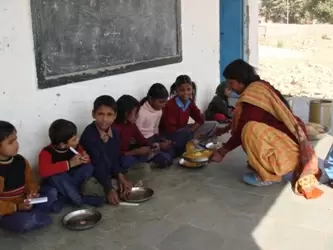Lokmitra trains parents to mind the functioning of wards’ school
02-August-2013
Vol 4 | Issue 31
It takes an informed and empowered community to harvest the fruits of educational entitlements, including non-discriminatory access to midday meals.
The promises made in the Right to Education Act can only be wrested as rights when they are owned by the community, and this sense of ownership can only be developed through social campaigns and interventions.
 |
|
The availability of a warm lunch in school has helped to arrest the phenomenon of children from poor communities dropping out of school (Photo: Neena BhandariWFS)
|
India’s Mid Day Meal Scheme reaches 120 million children in over 12.65 lakh schools and nutrition centres across the country. The idea behind it was to provide two fundamental entitlements guaranteed by the Indian constitution – namely the right to food and the right to education.
The availability of a warm lunch in school has helped to arrest the phenomenon of children from poor communities – especially those that are discriminated against like dalits – dropping out of school.
The midday meal tragedy in Bihar has drawn attention directly to the way we articulate and work for educational entitlements, including, of course, the Mid Day Meal Scheme. Our approach can no longer afford to be casual and random. Instead, it has to be systematically embedded in a process that engages the community, parents and teachers.
That is why the story of Nazia Jahan is so important. Coming from a community that reflects some of the poorest educational levels in the country, Nazia was hesitant to even visit her children’s school, let alone ask the teachers about the schooling they were getting.
She was illiterate, came from the Muslim community, and like most people living in poverty, education was the last thing on her mind. A resident of the the Ramteerath ward of Lucknow, Uttar Pradesh, the 32-year-old has five children. Her husband made small amounts of money to support the family by taking up odd jobs as a cleaner in the city’s neighbourhoods.
Nazia’s own journey to find a voice and get it heard has led to the School Management Committee (SMC) in her son’s school getting transformed into a vibrant platform. In the process, she has demonstrated that the functioning of the school and the education it imparts needs to be the collective responsibility of parents, teachers and the school management.
In February 2013, Lokmitra – a partner with our organisation, the Poorest Areas Civil Society (PACS) programme – introduced Nazia to a training model that sets out to build the capacity of the community to understand and engage with issues of discrimination under the Right to Education Act.
Accessing entitlements under the Act is also a part of the learning. The young mother then went on to use her new understanding and capacity to engage with the school for provisions that she and others like her had been denied because of general apathy on the part of the school.
The Narhi Primary School in Ramteerath ward, where Nazia’s children studied, has seven classrooms. But the paucity of teachers and lack of interest by the management led to different batches of children being made to sit together within the same room. For instance, Class I and Class II would have their classes within a single classroom. What learning went on in such circumstances can only be imagined.
The problem was that the members of the SMC were neither aware of their responsibilities and power, nor were they motivated to do something about the education that was being imparted to their children. It was here that Nazia could make a difference.
“I did not have confidence or information on how to approach the school on the way my child was being taught. I did not even know that there is a committee and parents can be part of it,” she recalls, highlighting one of the biggest challenges in implementation of the Right to Education Act’s provision of participatory and shared accountability on the functioning of the school.
The law envisages a powerful school-community interface through SMCs to address the realities of exclusion and discrimination.
Empowering Nazia to talk to parents and the local community, and take up the issue with the school principal was Lokmitra.
The organisation has adopted a model – evolved in partnership with PACS – that trains socially excluded groups through the SMC and enables them to monitor school activities and functioning; prepare and recommend a school development plan; become involved in grant utilisation planning and follow up on the attendance of both teachers and students.
 |
|
Lokmitra’s project has benefited several families who have been made aware of their rights (Courtesy: PACS)
|
The model also trains parents from socially excluded groups on ways to lobby with schools. This is done through interactive exercises and sharing of experiences through role-playing. In this way, SMC members learn how to pitch an issue to the school authorities. They also understand the various forms of discrimination that manifest themselves in schools.
After these trainings are completed, Lokmitra's cluster managers assist the SMC to conduct regular meetings, speak to school authorities, monitor school budgets and supervise the Mid Day Meal Scheme.
Nazia is just one mother who has evolved from being absolutely ignorant to becoming a pro-active member of the school SMC. In fact, today she heads the committee. Under her watch, the community may be sure that the Mid Day Meal provided to the schoolchildren of Narhi Primary School will be safe and wholesome.
(Singh is head of Advocacy and Communications, and Sarkar is Knowledge and Communication Manager, PACS.) - Women's Feature Service














